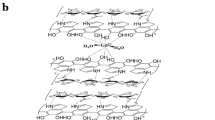Abstract
The preparation of β-EgadMe and α-EgadMe, magnetic resonance (MR) contrast agents that can be used for in vivo detection of β-galactosidase, is described. Diastereomerically pure β-EgadMe can be synthesized by kinetically resolving the starting material as described in Step 1. The total time for the preparation of the racemic mixture of β-EgadMe is about 8 d, and the total time for an diastereomerically resolved agent is about 9 d. The final metallated agent is stable at room temperature as a solid or in aqueous buffer (pH 5.5–10) indefinitely. Diastereomerically pure α-EgadMe can be prepared by beginning the synthesis with enantiomerically pure bromopropionic acid. The total time for the preparation of racemic α-EgadMe or diastereomerically pure α-EgadMe is about 8 d. The final metallated agent is stable at room temperature as a solid or in aqueous buffer (pH 5.5–10) indefinitely.
This is a preview of subscription content, access via your institution
Access options
Subscribe to this journal
Receive 12 print issues and online access
$259.00 per year
only $21.58 per issue
Buy this article
- Purchase on Springer Link
- Instant access to full article PDF
Prices may be subject to local taxes which are calculated during checkout




Similar content being viewed by others
References
Spergel, D.J. Using reporter genes to label selected neuronal populations in transgenic mice for gene promoter, anatomical, and physiological studies. Prog. Neurobiol. 2001; 63, 673–686.
Alauddin, M.M., Louie, A.Y., Shahinian, A.M., Meade, T.J. & Conti, P.S. Receptor mediated uptake of a radiolabeled contrast agent sensitive to β-galactosidase activity. Nucl. Med. Biol. 2003; 30, 261–265.
Louie, A.Y. et al. In vivo visualization of gene expression using magnetic resonance imaging. Nat. Biotechnol. 2000; 18, 321–325.
Moats, R.A., Fraser, S.E. & Meade, T.J. A 'smart' magnetic resonance imaging agent that reports on specific enzymatic activity. Angew. Chem. 1997; 36, 726–728.
Caravan, P., Ellison, J.J., McMurry, T.J. & Lauffer, R.B. Gadolinium(III) chelates as MRI contrast agents: structure, dynamics, and applications. Chem. Rev. 1999; 99, 2293–2352.
Jacobs, R.E. & Fraser, S.E. Magnetic resonance microscopy of embryonic cell lineages and movements. Science 1994; 263, 681–684.
Mellin, A.F. et al. Three dimensional magnetic resonance microangiography of rat neurovasculature. Magn. Reson. Med. 1994; 32, 199–205.
Merbach, A.E. & Toth, E. The Chemistry of Contrast Agents in Medical Magnetic Resonance Imaging (John Wiley and Sons Ltd., West Sussex, 2001).
Lauffer, R.B. Paramagnetic metal complexes as water proton relaxation agents for NMR imaging: theory and design. Chem. Rev. 1987; 87, 901–927.
Bertini, I. & Luchinat, C. NMR of Paramagnetic Molecules in Biological Systems (Benjamin/Cummings, Menlo Park, California, 1986).
Koenig, S.H. & Keller, K.E. Theory of 1/T1 and 1/T2 NMRD profiles of solutions of magnetic nanoparticles. Magn. Reson. Med. 1995; 34, 227–233.
Peters, J.A., Huskens, J. & Raber, D.J. Lanthanide induced shifts and relaxation rate enhancements. Prog. Nucl. Magn. Reson. Spectrosc. 1996; 28, 283–350.
Urbanczyk-Pearson, L.M. et al. Mechanistic investigation of β-galactosidase-activated MR contrast agents. Inorg. Chem. 2008; 47, 56–68.
White, D.E. & Jacobsen, E.N. New oligomeric catalyst for the hydrolytic kinetic resolution of terminal epoxides under solvent-free conditions. Tetrahedron Asymmetry 2003; 14, 3633–3638.
Ghosh, I., Zeng, H. & Kishi, Y. Application of chiral lanthanide shift reagents for assignment of absolute configuration of alcohols. Org. Lett. 2004; 6, 4715–4718.
Author information
Authors and Affiliations
Corresponding author
Supplementary information
Supplementary Fig. 1
Proposed mechanisms of the enzymatic transition of β-EgadMe and α-EgadMe from weak to strong relaxivity states (PDF 97 kb)
Supplementary Fig. 2
MR images of β-EgadMe exposed to heat-treated β-galactosidase (left) and active β-glactosidase (right) (PDF 63 kb)
Supplementary Fig. 3
MRI detection of regions positive for β-galactosidase within a single living Xenopus laevis embryo. (PDF 88 kb)
Rights and permissions
About this article
Cite this article
Urbanczyk-Pearson, L., Meade, T. Preparation of magnetic resonance contrast agents activated by β-galactosidase. Nat Protoc 3, 341–350 (2008). https://doi.org/10.1038/nprot.2007.529
Published:
Issue Date:
DOI: https://doi.org/10.1038/nprot.2007.529
Comments
By submitting a comment you agree to abide by our Terms and Community Guidelines. If you find something abusive or that does not comply with our terms or guidelines please flag it as inappropriate.



